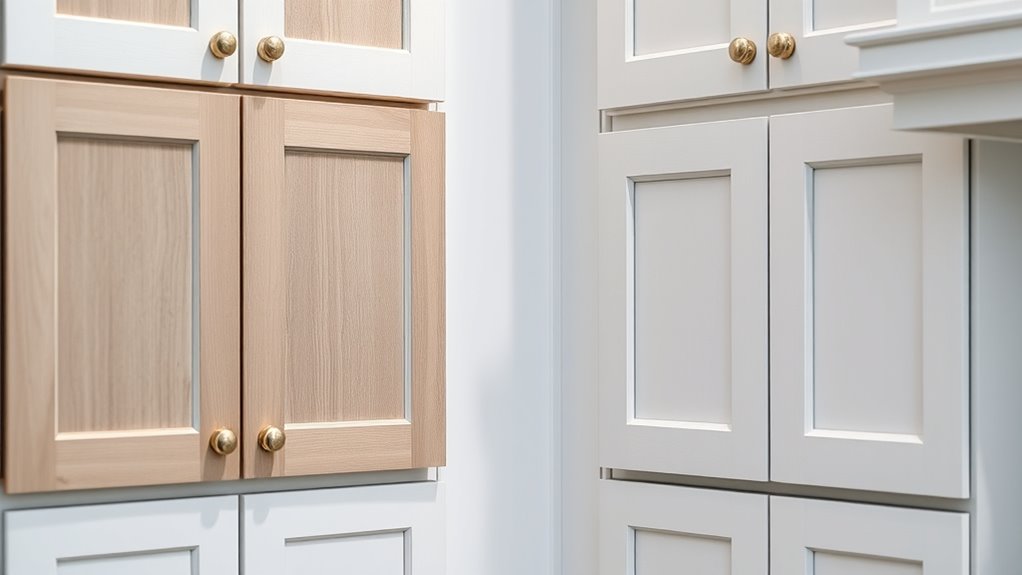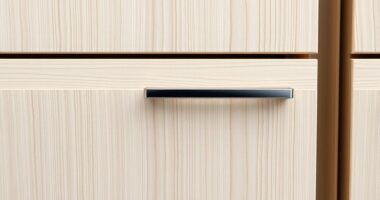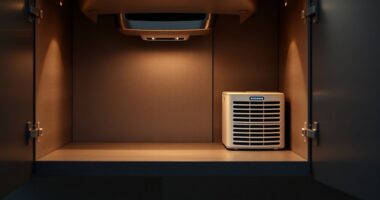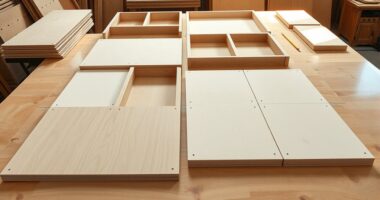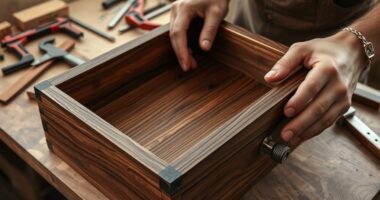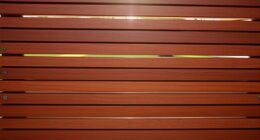Inset cabinets require precise clearances and careful hinge choices because the doors sit flush within the frame, demanding tight tolerances for smooth operation and even gaps. Overlay cabinets are more forgiving, with doors covering most of the frame, making adjustments easier and less exact. Your hinge selection—full or partial overlay—will impact how well your cabinets align and function. Keep exploring to discover tips for ensuring a perfect fit with either style.
Key Takeaways
- Inset cabinets require precise hinge adjustments for tight, even gaps, while overlay cabinets tolerate minor misalignments due to door coverage.
- Full-overlay hinges are preferred for inset cabinets to achieve accurate door movement and minimal gaps.
- Overlay cabinets offer more forgiving clearances, simplifying installation and hinge adjustments.
- Tight tolerances in inset cabinets make hinge calibration critical for a seamless, flush look.
- Overlay designs reduce the need for meticulous measurements, easing hinge choice and alignment during installation.
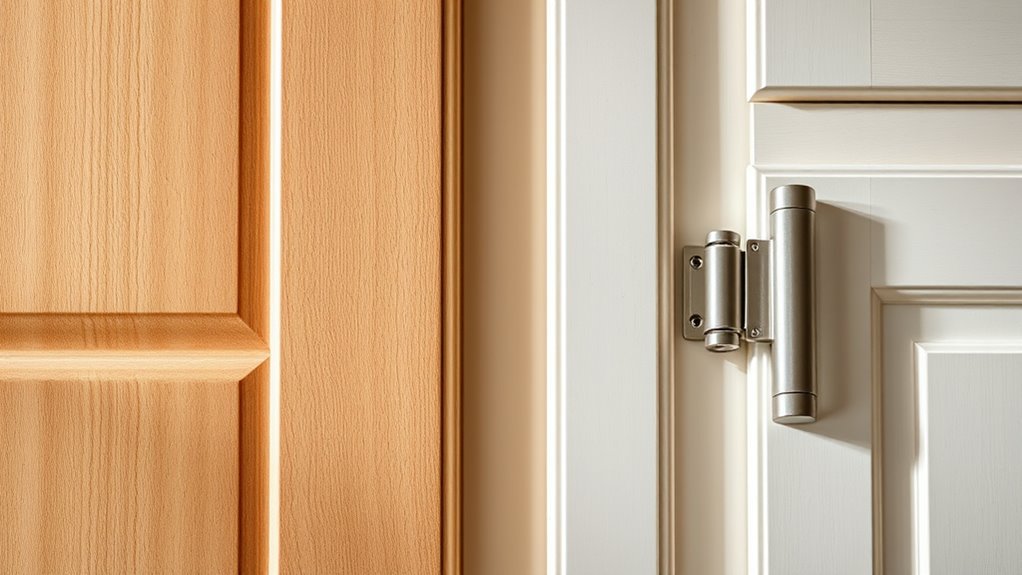
Are you trying to decide between inset and overlay cabinets for your kitchen? The choice can markedly impact your cabinet installation process, especially when it comes to how the doors align and operate. Inset cabinets are designed so that the door sits flush within the cabinet frame, requiring precise measurements and careful hinge adjustments during installation. Because the doors are inset, even small miscalculations can cause sticking or uneven gaps, making hinge adjustments essential for a perfect fit. On the other hand, overlay cabinets feature doors that sit over the frame, covering most of the cabinet box. This design offers more flexibility during installation, as the door overlaps hide minor misalignments and reduce the need for meticulous hinge adjustments.
When it comes to clearances, inset cabinets demand tighter tolerances. Since the doors are flush with the frame, any variation in hinge placement or cabinet dimensions can lead to misalignment. You’ll need to pay close attention during cabinet installation, ensuring hinges are precisely adjusted to keep gaps even and the doors closing smoothly. This process involves fine-tuning hinge adjustments after hanging the doors, which can be time-consuming but results in a sleek, seamless appearance. Conversely, overlay cabinets provide more forgiving clearances. Because the doors cover the frame, slight deviations in hinge positioning are less noticeable, making the cabinet installation process more straightforward. You might still need to make hinge adjustments, especially if you want to fine-tune the door alignment, but the overall process tends to be less demanding.
Hinge choices are critical regardless of the cabinet style. For inset cabinets, you’ll often want full-overlay hinges that allow for precise door movement and minimal gaps. These hinges need to be adjustable in multiple directions, so you can fine-tune the door position after installation. When working with overlay cabinets, you can opt for either traditional or soft-close hinges, depending on your preference. Overlay hinges are generally easier to install and adjust, thanks to their design that accommodates slight misalignments. Whether you’re installing inset or overlay cabinets, knowing how to make hinge adjustments is essential. Proper hinge adjustment not only improves the door operation but also ensures your cabinets look uniform and polished.
Frequently Asked Questions
How Do Hinge Types Differ Between Inset and Overlay Cabinets?
You’ll find that hinge types differ mainly in their adjustment and how they support cabinet alignment. Inset cabinets typically use European or concealed hinges, which allow precise hinge adjustment to ensure perfect door alignment within the frame. Overlay cabinets often use European or semi-concealed hinges, providing easier installation and adjustment. Your choice influences hinge adjustment ease and how well your cabinets stay aligned over time, making a big difference in overall appearance.
What Are the Typical Installation Challenges for Inset Cabinets?
Think of installing inset cabinets like fitting a vintage watch into a modern case—you need precision. Your main challenges include achieving perfect hinge alignment and cabinet leveling, which can be tricky since inset doors sit flush with the frame. Small misalignments become noticeable, requiring careful adjustments. Ensuring the hinges are aligned correctly and the cabinets are level prevents uneven gaps and doors that don’t close smoothly.
How Do Cabinet Clearances Affect Kitchen Workflow?
Your cabinet clearances directly impact your kitchen workflow by ensuring smooth door operation and easy access. Adequate space allows for proper cabinet ventilation, preventing heat buildup and moisture issues. It also enhances aesthetic integration, giving your kitchen a seamless, polished look. Too tight, and you may struggle to open doors or find clutter, while too loose can look sloppy. Striking the right balance optimizes both functionality and visual appeal.
Are There Maintenance Differences Between Inset and Overlay Cabinets?
You’ll find that inset cabinets require a bit more cabinet maintenance since their hinges often need more precise adjustments over time. Overlay cabinets tend to have hinge longevity because they use more robust hardware. It’s like comparing apples to oranges—your choice impacts upkeep. Regularly checking hinges and keeping hinges clean helps extend their lifespan, ensuring your cabinets stay functional and beautiful without a hitch.
Which Cabinet Style Offers Better Durability Over Time?
You’ll find that inset cabinets often offer better durability over time because their material longevity is higher, thanks to fewer stress points. Their finish durability also tends to last longer, as the finish is less exposed to chipping or peeling. Overlay cabinets, while easier to maintain, might not hold up as well, especially if you choose less durable materials or finishes. Overall, inset cabinets tend to be the more durable choice long-term.
Conclusion
So, whether you choose inset or overlay cabinets, remember that the perfect fit isn’t just about style—it’s about compromise. Ironically, the more you prioritize seamlessness, the more you might struggle with hinges and clearances. In the end, your dream kitchen’s harmony depends on balancing aesthetics with practicality. Sometimes, the most polished look is just a clever workaround away, proving that even in cabinetry, perfection comes with a dash of compromise.
